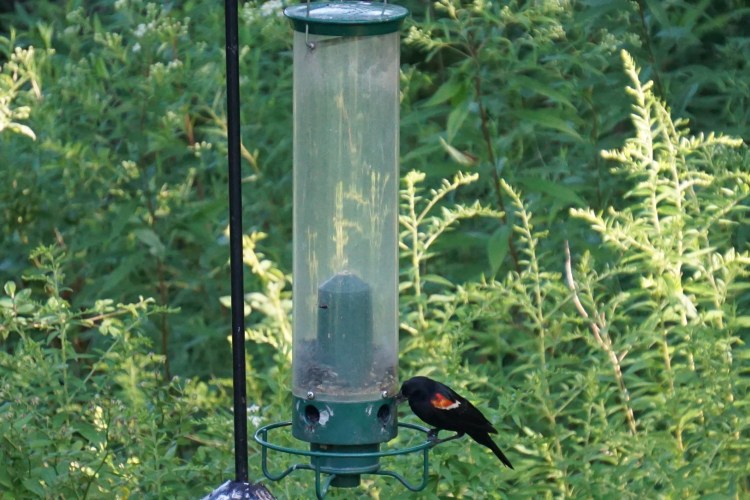
It feels worth starting this column by acknowledging this was a weird year for our birds, especially as it relates to the nesting season. The spring migration saw a slightly early start for several species because of favorable weather conditions, but the brakes were quickly applied as low pressure systems slowed their progression. With that low pressure came lots of rain; how many weekends did we “lose” this spring to the rain (and did it really rain 10 Saturdays in a row)? Those storms apparently caused a lot of birds to have failed nests — especially ground nesters like wild turkeys — but it set up a great growing season for plants that are now producing lots of fruit and seeds.
I needed to preface this column with that rollercoaster of busts and booms, because an atypical summer has led to a lot of atypical behavior from wildlife. A great example is this week’s inquiry from Carolyn Smith of South Portland, asking why red-winged blackbirds were spending more time around their bird feeders in June than usual. As you can probably guess from the intro, this can likely be explained by food availability.
In most years, red-winged blackbirds begin to migrate back to Maine in the earliest of spring days. They are not long-distance migrants, with most wintering in the United States, so they can cue into local weather and move north as soon as it begins to warm. With increasingly warmer winters, we are seeing red-winged blackbirds arrive earlier than they were even a couple of decades ago; now most arrive in Maine by March. If you have bird feeders out, you probably see them among the mixed flocks of blackbirds, often dominated by common grackles, that descend on feeders in the spring.
Red-winged blackbirds typically eat seeds throughout the non-breeding season, from late summer to early in the following spring. In a few studies from their wintering areas, their diets were primarily plant matter, with only 2-8% of their diet made up of insects. There is quite a lot of interest in what blackbirds eat in the winter, because that other 92-98% is seeds, which often come from agricultural areas where corn and sunflower seeds make up most of their diet.
Come summer, most birds need to switch their diets from seeds/plants to insects. It’s nutritionally important for adults, but even more essential for their developing young. A study by Bird and Smith from Manitoba on “food habits of red-winged blackbirds” found that during the breeding season, blackbirds nesting near agricultural areas, where seeds were abundant, still had 70% of their diet made up of animal matter (mostly insects), while those nesting in marshes had 100% insect-based diets. At Maine Audubon, we spend a lot of time talking about the importance of native plants on the landscape to support wildlife. The connection to remember is that we need native plants because they support the insects that birds need, and thus are the basis of the food chain.
One of the most fascinating things about red-winged blackbirds is the physiological changes their bodies go through with this big shift from plant- to animal-based diets, known as digestive plasticity. Kristin Brugger from the University of Florida published a study in The Auk focused on these changes in gastrointestinal features of blackbirds based on their diet. To oversimplify: blackbirds’ gizzards, small intestines and villi (for absorption) are smaller when their diet is protein-rich (from insects in summer). The types of digestive enzymes produced also change to help breakdown the seasonally abundant food.
All this said, if the food isn’t there, the birds need to adapt and perhaps even delay nesting. So in Carolyn’s case, I suspect that the abundant rain in the spring made it harder for those red-winged blackbirds to nest, and they probably weren’t finding the food (insects) they needed until the weather improved. Supplementing their diet with seeds during this period was likely an easy alternative. That would not be an option for their young come July. Most blackbirds are wrapping up nesting by mid July, at least having their chicks fledged by then, but the delayed nesting this spring meant we were still getting reports of very territorial birds (defending nests) through the end of the month.
As we move through August, the fall songbird migration is already beginning. I know this based on all the phone calls we get each fall asking how people can keep the blackbird flocks away since they aren’t always the most appreciated of visitors. Hopefully this look into the amazing adaptations they go through helps you to see them in a new light.
Have you got a nature or wildlife question of your own? It doesn’t have to be about birds! Email questions to [email protected] and visit www.maineaudubon.org to learn more about birding, native plants, and programs and events focusing on Maine wildlife and habitat. Maine Audubon Staff Naturalist Doug Hitchcox and other naturalists lead free bird walks on Thursday mornings starting at 7 am, at Maine Audubon’s Gilsland Farm Audubon Sanctuary in Falmouth.
We invite you to add your comments. We encourage a thoughtful exchange of ideas and information on this website. By joining the conversation, you are agreeing to our commenting policy and terms of use. More information is found on our FAQs. You can modify your screen name here.
Comments are managed by our staff during regular business hours Monday through Friday as well as limited hours on Saturday and Sunday. Comments held for moderation outside of those hours may take longer to approve.
Join the Conversation
Please sign into your Sun Journal account to participate in conversations below. If you do not have an account, you can register or subscribe. Questions? Please see our FAQs.